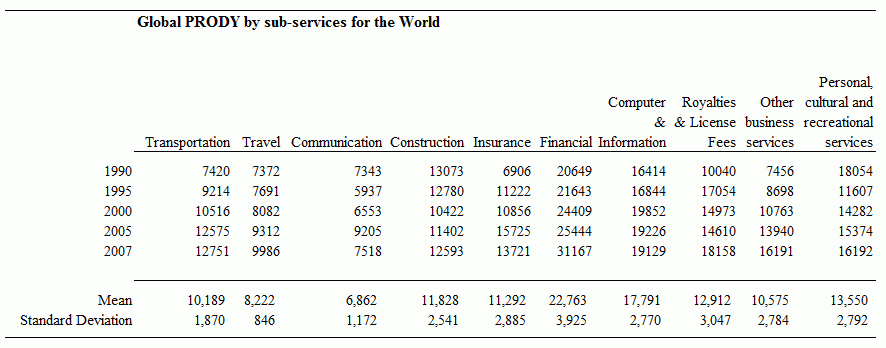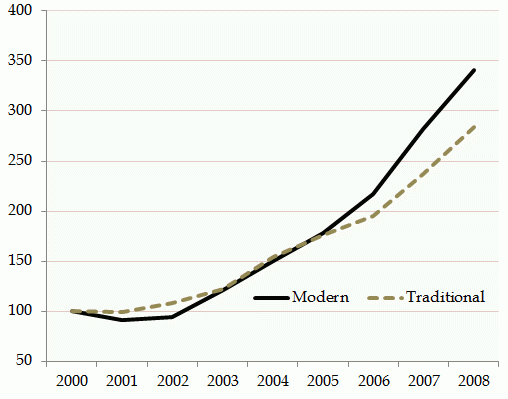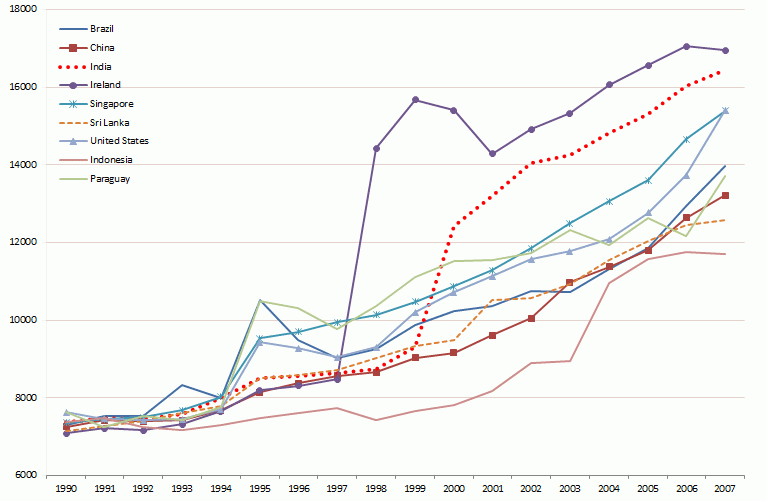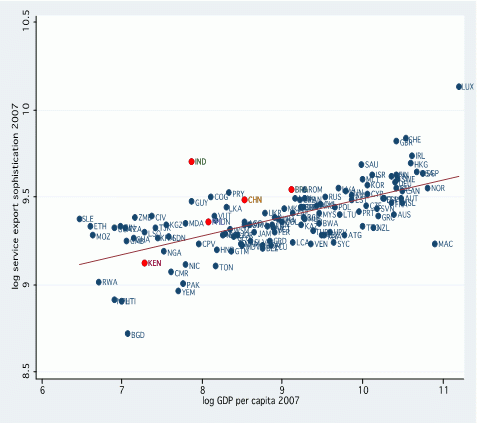The rapid growth of China and India has rekindled the debate on the drivers of growth and development. China’s growth is led by traditional manufacturing, while India’s growth focuses heavily on services – two entirely different paths towards rapid development (see Bosworth and Collins 2008). Traditional theory and thinking focus on development as a transition from agricultural to industrial production, with manufacturing being the prime ‘engine of growth’.
Innovations in technology and business processes have been changing the very nature of the production frontier for service activities. This has led to a growing share of services in GDP growth and in particular to a rapid increase in service exports. In the last decade, services have grown as a share of the world’s GDP, accounting for 70% of global GDP; and service exports in developing countries have almost tripled between 1997 and 2007.1
The mid-1990s saw two seemingly separate but related developments.
- The revolution in information and communication technology; and
- Rapid developments in those global forces often referred to as the 3Ts – technology, transportability, and tradeability (see Ghani and Kharas 2011).
These two events had a profound impact on the nature, productivity, and tradeability of services (Baldwin 2011). As far as services are concerned, they resulted in the rapid growth of what can be called modern services, such as information technology, business-related, transcribing medical records, data services, call centres, education, entertainment production services, etc. These services differ significantly from the traditional services, which demand face-to-face interaction.
This can be seen in many success stories:
- The Nigerian film industry,
- Call centres in Kenya,
- Business consulting and knowledge-processing offices in Singapore,
- Accountancy services in Sri Lanka,
- Human-resources processing firms in Abu Dhabi,
- And more generally, the growing internationalisation of innovation, R&D, design, and marketing.
These are all different forms of the same phenomenon that includes diversification and moving up the value chain in niche tasks to strategically redesign comparative advantage.
Overall, these developments imply that services have become increasingly similar to manufacturing goods in the sense that they benefit from technological advances and benefit from the potential gains from specialisation through economies of scale, agglomeration, network effects, and division of labour. In addition, these sophisticated services mostly require digital labour mobility, providing an opportunity for relatively innovative high-tech job creation in low- and middle-income economies.
Service export sophistication: A new growth path
There are two aspects of this new channel for growth – specialisation within service exports and the sophistication of service exports. Whereas increasing export volume in niche products or services fuels growth, the more interesting question is whether growth can be achieved by improving the sophistication of service exports. This is in line with the existing literature on how sophistication of goods exports affects growth. Hausmann et al (2007) have shown that it is not the specialisation alone, but the sophistication of goods exports that matters for growth.2 To examine this phenomenon for service exports, we create an index called ‘service export sophistication’.
We first construct an index named PRODY that was previously created for each category of goods exports, reflecting the income/productivity level associated with each good; and we do the same for each category of services present in the International Monetary Fund Balance of payments. The service PRODYs are proxies for the expected income/productivity level associated with a particular service category. We construct it for each service category, for each year of analysis (PRODYs are the same for all countries). The sum of the GDP of countries exporting a particular service, weighted by their specialisation service export sophistication (service EXPY) is then the weighted income value of services exported by a country, computed as the sum of PRODYs weighted by the share of the particular service in the country’s total service exports basket. Service EXPYs are constructed for each country and for each year of available data. Table 1 shows the average PRODYs for different service exports categories. To look at the evolution of service exports sophistication over time, we plot selected countries’ service EXPY in Figure 1. In Figure 2, we plot the average-level correlation for 2007. We can see the relative position of each country for its stage of development. India and China started in the early 1990’s at relatively similar stages of development and sophistication; increasingly India is a big positive outlier in exporting sophisticated services.
Table 1. PRODYs for service export categories
Source: Authors’ calculation. Note: SD=standard deviation.
Figure 1. Modern service exports are growing fast, World (2000=100)
Source: authors’ calculation. Note: Modern Services include communication, insurance, finance, computer & information, royalties and license fees and other business services. Traditional service are Transport, Travel, Construction, Personal, cultural and recreational services
Figure 2. Service export sophistication for selected countries
Source: Authors’ calculation.
Figure 3. Service export sophsitication against GDP per capita 2007
Source: authors’ calculation.
Relationship to growth
We conducted an empirical growth regression analysis to test whether service EXPY is positively associated with growth (see Mishra et al 2011).3 The results indicate that exports’ ‘quality’ in services is positively associated with growth performance. The results hold even after controlling for income per capita, skills, the size of the domestic service sector, goods sophistication, financial development, institutional quality, and country time-invariant factors. The results hold dropping advanced countries and India from the sample. Our global results suggest that this phenomenon is growing in importance over time. Service exports and an increase in their sophistication may be an additional channel for sustained high growth. We highlight a need to refocus policy debate on the drivers of growth. Learning from this phenomenon in development policy practice will depend on country-specific factors and is ongoing work.
Countries may benefit by adopting policies that increase the value-added by service exports, improve productivity, eliminate obstacles to increasing sophistication in niche service activities, and promote service export performance. Neither the manufacturing-led growth strategy of China nor India’s information technology-enabled service exports growth can be a universal platform for growth and economic development, but there are lessons to be learned from their experiences.
The distinctiveness of increasing service exports sophistication and growth is twofold:
(1) Traditional service activities gain in productivity from technology, transportability, and tradeability; and
(2) There is a host of new service activities that have emerged (as a result of unbundling and technological innovation).
Increasing sophistication in service exports has important implications for countries that are stuck in a ‘middle-income trap’ such as Malaysia, Vietnam, etc, or for countries that wish to sustain their rapid growth such as India, Sri Lanka, etc. Further, reigniting growth in United States and G20 economies will also rely on innovation and competitiveness in sophisticated service-exporting firms. It also offers a prospective route for growth in Africa. In the global rebalancing, service exports might be an imperative channel either through the lens of India-China, South-South trade, advanced-emerging trade clusters and possible new trade networks.
Concluding remarks
There are many examples but in particular the Indian experience has shown that even when only around 1% of its population is engaged in high productivity service exports, it contributes to overall high growth. Technology is embedded in service and not services in technology. Various factors may promote competitiveness among service exporting countries thus driving specialisation and sophistication in service exports. Countries should continue to build on specialisation, but also extend this idea to sophistication in service activities as a potential route to economic growth.
The views expressed here are those of the authors and not necessarily of the World Bank, International Monetary Fund or any other institution.
References
Bosworth, Barry, and Susan M Collins (2008), “Accounting for Growth – Comparing China and India”, Journal of Economic Perspectives, 22(1): 45–66.
Escaith, Hubert (2008), “Measuring Trade in Value Added in the New Industrial Economy: Statistical Implications”, Unpublished manuscript, World Trade Organization.
Francois, Jospeh, and Bernard Hoekman (2010), “Services Trade and Policy”, Journal of Economic Literature, 48(3):642–92.
Ghani, Ejaz, and Homi Kharas (2010), “Overview” in Ghani, Ejaz (ed), The Service Revolution in South Asia, Oxford: Oxford University Press.
Hausmann, Ricardo, Jason Hwang, and Dani Rodrik (2007), “What You Export Matters”, Journal of Economic Growth, 12(1):1–25.
Lall, Sanjaya, John Weiss, Jinkang Zhang (2005), “The Sophistication of Exports: A New Measure of Product Characteristics”, Queen Elizabeth House Working Paper Number 123.
WTO (2009), International Trade Statistics 2009, Geneva: World Trade Organization.
1 The global value of cross-border services exports in 2007 was $3.3 trillion (20% of total world trade). However, the share of services rises to almost 50% if transactions are measured in terms of direct and indirect value-added content – that is, if measured in terms of processing of imported components into final products for export (Escaith 2008). If we add the sales of services by foreign affiliates of multinational firms, then the value of trade in services rises further. Data for 15 OECD countries put the value of such sales at around $1.5 trillion in 2007 (WTO 2009, Francois and Hoekman 2010).
2 See also Lall et al 2005 on production sophistication.
3 See Mishra et al (2011) for details on construction of the service EXPY measure:









